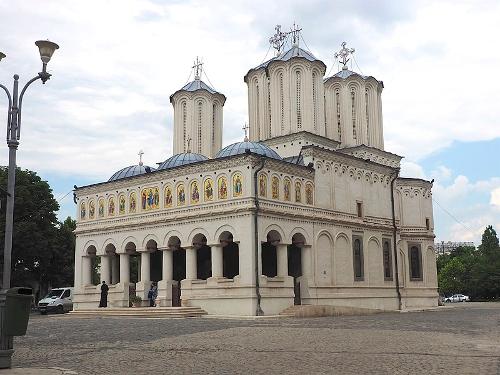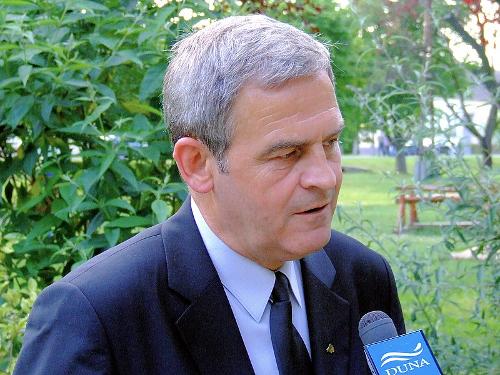ROMANIA
Religion

Religion
Cities in ROMANIA
| Brasov | Bucharest |
Religion
The Romanians are the only Romanesque people that are not Catholic but Orthodox. From the 3rd century on, the area north of the Danube was Christianized by Latin and Byzantine missionaries. In the Middle Ages, Orthodox Romanian Christians adopted the Slavic Rite, and Church Slavic was the liturgical language for centuries. At a later stage this became New Greek and later Romanian. In 1864 the Romanian Orthodox Church managed to break away from the Patriarchate of Constantinople and became independent.
 Pariarchal Orthodox Cathedral in Bucharest, RomaniaPhoto: Clay Gilliland CC 2.0 Generic no changes made
Pariarchal Orthodox Cathedral in Bucharest, RomaniaPhoto: Clay Gilliland CC 2.0 Generic no changes made
Freedom of religion is guaranteed in the new 1991 constitution. The relationship between the church and the state was already regulated in 1948, whereby, among other things, the salaries of church officials were partly paid by the state. Under the communists, the Romanian Orthodox Church was allowed, but its assets were all confiscated in 1974. Furthermore, many Roman Catholic priests and bishops were deported and the Greek Catholic faith was outlawed.
Many ecclesiastical authorities were even secret agents and passed on confessional secrets to the hated security service Securitate. The head of the Romanian Orthodox Church at the time, Patriarch Teoctist, therefore resigned in January 1990. His succession, however, was such a problem that he took over the leadership of the Church again in April. A real renewal of the Romanian Orthodox Church therefore failed to materialize. Since 1990, the church has been disconnected from the state again and, for example, the Greek Catholic Church became legal again.
 Roman Catholic Church RomaniaPhoto: Joe Mabel CC 3.0 Unported no changes made
Roman Catholic Church RomaniaPhoto: Joe Mabel CC 3.0 Unported no changes made
Romania has no fewer than sixteen large and small denominations. The mutual relationships do not always run smoothly and it has still not come to an ecumenism.
Approx. 70% of the population belongs to the Romanian Orthodox Church and about 6% of the population is Roman Catholic (uniates) or Greek Catholic.
Smaller movements include the Evangelical Church of the Augsburg Confession or Lutheran Church, the Reformed (Calvinist) Church, the Synodal Presbyterians, the Unitarian (anti-Trinitarian) Church, the Pentecostal Church, the Gospel Christians and the Old Rite Christian Church. Romania also has a small number of Orthodox Armenians, Jews and Muslims. Most of the Muslim mosques can be found in the Dobruja with Turkish communities in Constanta and Mangalia.
The highest authority of the Romanian Orthodox Church is the Holy Synod, which has 33 bishops and has its own patriarchate from 1925. The Romanian Orthodox Church has twenty theological seminaries, where more than 4000 students study.
 László Tökes, RomaniaPhoto: Csanády in the public domain
László Tökes, RomaniaPhoto: Csanády in the public domain
The Reformed Church is the largest Protestant faith community in Romania and its members are mainly of Hungarian descent. The Reformed Church was best known abroad for the activities of Reverend László Tökes in 1989. He was forcibly transferred to another congregation, leading up to the fall of dictator Ceausescu.
The Jewish community has shrunk by about 400,000 people since the arrival of the communist regime in 1948, many Romanian Jews emigrated to Israel. At the moment there are officially only about 10,000 Jews in Romania. As with the gypsies, the number is probably much higher, perhaps around 20,000.
Sources
Bos, J.W. / Roemenië : mensen, politiek, economie, cultuur, milieu
Koninklijk Instituut voor de Tropen
Democratisering aan de Donau : Roemenië na de revolutie van 1989
Instituut voor Publiek en Politiek
Roemenië
Steunpunt Oost-Europa Projecten
Versteegen, J. / Roemenië
Gottmer
Williams, N. / Romania & Moldova
Lonely Planet
CIA - World Factbook
BBC - Country Profiles
Copyright: Team The World of Info